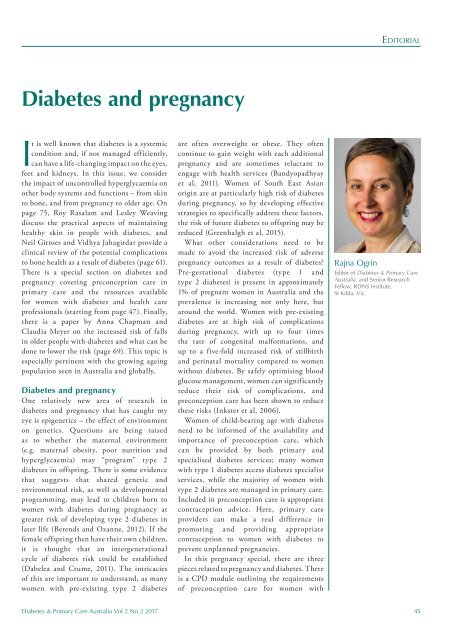DPCA2-2_issue_v3
Create successful ePaper yourself
Turn your PDF publications into a flip-book with our unique Google optimized e-Paper software.
Editorial<br />
Diabetes and pregnancy<br />
It is well known that diabetes is a systemic<br />
condition and, if not managed efficiently,<br />
can have a life-changing impact on the eyes,<br />
feet and kidneys. In this <strong>issue</strong>, we consider<br />
the impact of uncontrolled hyperglycaemia on<br />
other body systems and functions – from skin<br />
to bone, and from pregnancy to older age. On<br />
page 75, Roy Rasalam and Lesley Weaving<br />
discuss the practical aspects of maintaining<br />
healthy skin in people with diabetes, and<br />
Neil Gittoes and Vidhya Jahagirdar provide a<br />
clinical review of the potential complications<br />
to bone health as a result of diabetes (page 61).<br />
There is a special section on diabetes and<br />
pregnancy covering preconception care in<br />
primary care and the resources available<br />
for women with diabetes and health care<br />
professionals (starting from page 47). Finally,<br />
there is a paper by Anna Chapman and<br />
Claudia Meyer on the increased risk of falls<br />
in older people with diabetes and what can be<br />
done to lower the risk (page 69). This topic is<br />
especially pertinent with the growing ageing<br />
population seen in Australia and globally.<br />
Diabetes and pregnancy<br />
One relatively new area of research in<br />
diabetes and pregnancy that has caught my<br />
eye is epigenetics – the effect of environment<br />
on genetics. Questions are being raised<br />
as to whether the maternal environment<br />
(e.g. maternal obesity, poor nutrition and<br />
hyperglycaemia) may “program” type 2<br />
diabetes in offspring. There is some evidence<br />
that suggests that shared genetic and<br />
environmental risk, as well as developmental<br />
programming, may lead to children born to<br />
women with diabetes during pregnancy at<br />
greater risk of developing type 2 diabetes in<br />
later life (Berends and Ozanne, 2012). If the<br />
female offspring then have their own children,<br />
it is thought that an intergenerational<br />
cycle of diabetes risk could be established<br />
(Dabelea and Crume, 2011). The intricacies<br />
of this are important to understand, as many<br />
women with pre-existing type 2 diabetes<br />
are often overweight or obese. They often<br />
continue to gain weight with each additional<br />
pregnancy and are sometimes reluctant to<br />
engage with health services (Bandyopadhyay<br />
et al, 2011). Women of South East Asian<br />
origin are at particularly high risk of diabetes<br />
during pregnancy, so by developing effective<br />
strategies to specifically address these factors,<br />
the risk of future diabetes to offspring may be<br />
reduced (Greenhalgh et al, 2015).<br />
What other considerations need to be<br />
made to avoid the increased risk of adverse<br />
pregnancy outcomes as a result of diabetes?<br />
Pre-gestational diabetes (type 1 and<br />
type 2 diabetes) is present in approximately<br />
1% of pregnant women in Australia and the<br />
prevalence is increasing not only here, but<br />
around the world. Women with pre-existing<br />
diabetes are at high risk of complications<br />
during pregnancy, with up to four times<br />
the rate of congenital malformations, and<br />
up to a five-fold increased risk of stillbirth<br />
and perinatal mortality compared to women<br />
without diabetes. By safely optimising blood<br />
glucose management, women can significantly<br />
reduce their risk of complications, and<br />
preconception care has been shown to reduce<br />
these risks (Inkster et al, 2006).<br />
Women of child-bearing age with diabetes<br />
need to be informed of the availability and<br />
importance of preconception care, which<br />
can be provided by both primary and<br />
specialised diabetes services; many women<br />
with type 1 diabetes access diabetes specialist<br />
services, while the majority of women with<br />
type 2 diabetes are managed in primary care.<br />
Included in preconception care is appropriate<br />
contraception advice. Here, primary care<br />
providers can make a real difference in<br />
promoting and providing appropriate<br />
contraception to women with diabetes to<br />
prevent unplanned pregnancies.<br />
In this pregnancy special, there are three<br />
pieces related to pregnancy and diabetes. There<br />
is a CPD module outlining the requirements<br />
of preconception care for women with<br />
Rajna Ogrin<br />
Editor of Diabetes & Primary Care<br />
Australia, and Senior Research<br />
Fellow, RDNS Institute,<br />
St Kilda, Vic.<br />
Diabetes & Primary Care Australia Vol 2 No 2 2017 45
















